Kilkenny: Difference between revisions
m clean up, typos fixed: modern day → modern-day |
|||
| Line 777: | Line 777: | ||
|id= | |id= | ||
|isbn=}} | |isbn=}} | ||
{{Cities in the Republic of Ireland}} | |||
Revision as of 17:27, 30 March 2016
| Kilkenny Irish: Cill Chainnigh | |
| County Kilkenny | |
|---|---|
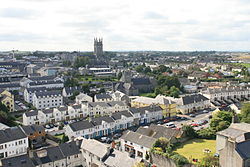
| |
| Location | |
| Grid reference: | S506563 |
| Location: | 52°38’52"N, 7°15’22"W |
| Data | |
| Population: | 24,423 (2011) |
| Dialling code: | 0353 |
| Local Government | |
| Dáil constituency: |
Carlow–Kilkenny |
| Website: | http://www.kilkennycity.ie |
Kilkenny is a city in County Kilkenny, in the southeast part of the Republic of Ireland. It is the county town. The city is built on both banks of the River Nore. It is an ancient borough with a Mayor and long tradition in 2009 the city celebrated its 400th year since the granting of city status in 1609, and within the borough boundary is a population of 8,711, albeit with the majority of the population outside the borough boundary; the 2011 Irish Census gives the total population of the Borough & Environs as 24,423.
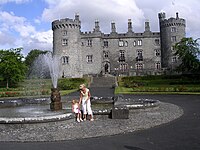
Kilkenny is a popular tourist destination. Kilkenny's heritage is evident in the city and environs including the historic buildings such as Kilkenny Castle, St Canice's Cathedral and round tower, Rothe House, Shee Alms House, Black Abbey, St Mary's Cathedral, The Tholsel (Town Hall), St. Francis Abbey, Grace's Castle, and St. John's Priory. Kilkenny is regarded for its culture with craft and design workshops, the Watergate Theatre, public gardens and museums.
Annual events include Kilkenny Art Festival, the Cat Laughs comedy festival and music at the Rhythm and Roots festival and the Source concert. It is a popular base to explore the surrounding towns, villages and countryside.
Kilkenny began with an early sixth century ecclesiastical foundation. Following Norman invasion of Ireland, Kilkenny Castle and a series of walls were built to protect the burghers of what became a Norman merchant town. William Marshall, Lord of Leinster, gave Kilkenny a charter as a town in 1207. By the late thirteenth century Kilkenny was under Norman-Irish control. The Statutes of Kilkenny passed at Kilkenny in 1367, aimed to curb the decline of the Hiberno-Norman Lordship of Ireland. In 1609 King James I granted Kilkenny a Royal Charter giving it the status of a city. Following the Rebellion of 1641, the Irish Catholic Confederation, also known as the "Confederation of Kilkenny", was based in Kilkenny and lasted until the Cromwellian conquest of Ireland in 1649. Kilkenny was a famous brewing centre from the late seventeenth century. In the late twentieth century Kilkenny is a tourist and creative centre.
The seat of the Roman Catholic Bishop of Ossory is at St Mary's Cathedral and the Church of Ireland Bishop of Cashel and Ossory is at St Canice's Cathedral. Nearby larger cities include Waterford 28 miles south-southeast, Limerick 58 miles west and Dublin 63 miles northeast.
Name

Kilkenny is the anglicised version of the Irish Cill Chainnigh, meaning "Cell/Church of Cainneach or Canice". This relates to a church built in honour of St Canice on the hill now containing St Canice's Cathedral and the round tower. This seems to be the first major settlement. The early Christian origin of the round tower suggests an early ecclesiastical foundation at Kilkenny.[1]
| “ | Ceall-Cainnigh was for the most part burned.[2] | ” |
The Annals of the Four Masters recorded Kilkenny in 1085.[3] Before this time, the early 6th century territory was known as Osraighe, referring to the whole district or the capital. The Four Masters entry was the first instance where the capital was called Ceall-Cainnigh (modernized Kilkenny).[4] Cill Chainnigh was a major monastic centre from at least the eighth century. There is no mention of Cill Chainnigh in the lives of Cainnech of Aghaboe, Ciarán of Saighir or any of the early annals of Ireland suggesting that Cill Chainnigh was not of ancient civil importance.[3]
History
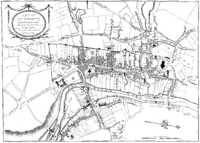
The history of Kilkenny began with an early sixth century ecclesiastical foundation, with a church built in honour of St Canice which is now St Canice's Cathedral, and was a major monastic centre from at least the eighth century. The Annals of the Four Masters recorded the first reference Cill Chainnigh in 1085. Prehistoric activity has been recorded suggesting intermittent settlement activity in the area in the Mesolithic and Bronze Age. Information on the history of Kilkenny can be found from newspapers, photographs, letters, drawings, manuscripts and archaeology. Kilkenny is documented in manuscripts from the 13th century onwards and one of the most important of these is Liber Primus Kilkenniensis.
The Kings of Ossory ('Osraige') had residence around Cill Chainnigh. The seat of diocese of Osraige was moved from Aghaboe to Cill Chainnigh. Following Norman invasion of Ireland, Richard Strongbow, as Lord of Lenister, established a castle near modern-day Kilkenny Castle. William Marshall]] began the development of the town of Kilkenny and a series of walls to protect the burghers. By the late thirteenth century Kilkenny was under Norman-Irish control. The original ecclesiastical centre at St Canice's Cathedral became known as Irishtown and the Anglo-Norman borough inside the wall came to be known as Hightown.
The Hiberno-Norman presence in Kilkenny was deeply shaken by the Black Death, which arrived in 1348. The Statutes of Kilkenny passed at Kilkenny in 1367, aimed to curb the decline of the Hiberno-Norman Lordship of Ireland. In 1609 King James I granted Kilkenny a Royal Charter giving it the status of a city. Following the Rebellion of 1641, the Irish Catholic Confederation, also known as the "Confederation of Kilkenny", was based in Kilkenny and lasted until the Cromwellian conquest of Ireland in 1649. James II of England spent most of the winter months from November 1689 until January 1690 at Kilkenny, residing in the castle.[5]
The Kilkenny Design Workshops were opened in 1965 and in 1967 the Marquess of Ormonde presented Kilkenny Castle to the people of Kilkenny. Today, the city has a lively cultural scene, with annual events including the Kilkenny Arts Week Festival in the last two weeks of August, and the Cat Laughs Comedy Festival at the beginning of June. The City has been referred to as the Marble City. People from Kilkenny are often referred to as Cats. The seat of the Roman Catholic Bishop of Ossory is at St Mary's Cathedral and the Church of Ireland Bishop of Cashel and Ossory is at St Canice's Cathedral.
Civic tradition
Kilkenny's first Council was elected in 1231 and since then Kilkenny has had a continuous record of municipal government. From the 13th century to the end of the 16th the chief magistrate was known as the Sovereign, and since then Mayor.
Kilkenny's city status is derived from a Royal Charter in 1609 by King James I. The Kilkenny Corporation originally had have a "Sovereign" and "Council of Twelve", but these have since been replaced by a Mayor and Councillors respectively.[6]
Sights of the town
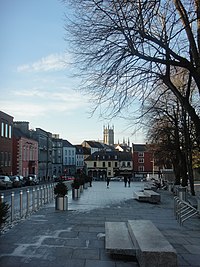
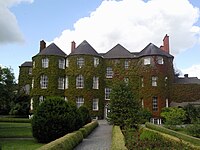
The Landmarks of Kilkenny show Kilkenny's heritage through the historical buildings. Kilkenny is a well preserved mediæval town and is dominated by both Kilkenny Castle and St Canice's Cathedral and round tower.
Kilkenny Castle and some important historical architecture of the mediæval city survive, like parts of the Kilkenny City Walls. They define the extent, layout and status of the mediæval town. The town grew from a monastic settlement to a thriving Norman merchant town in the Middle Ages. Saint Canice's Cathedral and round tower are an example of the monastic settlement and Rothe House is an example of an Elizabethan merchant townhouse.
The black stone with decorative white fossils that forms the backbone of many of Kilkenny's fine buildings was quarried locally, particularly from the Black Quarry located 1.6 km south of the city on the R700.[7]
Visitor Attractions in Kilkenny and its environs include Kilkenny Castle and Gardens including the Butler Gallery, St Canice's Cathedral and round tower, Rothe House and Garden, Shee Arms House, Grace's Courthouse, St Mary's Cathedral, The Tholsel (Kilkenny City Hall), the Dominican Black Abbey, St John's Church, Butler House, Kilkenny 'Slips' and St Francis Abbey Brewery.
Gardens include the Castle Rose Garden, Rothe House Garden, the Famine Memorial Garden and the garden of Butler House.
In the county other attractions include Kells Priory, Jerpoint Abbey, Ballykeeffe Amphitheatre, Warrington Top Flight Equestrian Centre, Dunmore Caves, Hoban Memorial, Kilfane Glen and waterfall, the watergarden in at camphill, Woodstock Estate and Jenkinstown Park.
Kilkenny Marble or Black Marble was exported to all corners of the British Empire.
Kilkenny Castle and city walls
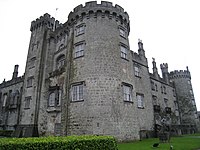
Kilkenny Castle in Kilkenny city was the seat of the Butler family. Formerly the family name was FitzWalter. The castle was sold to the local Castle Restoration Committee in the middle of the 20th century for £50. Shortly afterwards it was handed over to the State, and has since been refurbished and is open to visitors. Part of the National Art Gallery is on display in the castle. There are ornamental gardens on the city side of the castle, and extensive land and gardens to the front. It has become one of the most visited tourist sites in Ireland.
The first stone castle was begun in 1204 by William Marshall the site was completed in 1213; it was a symbol of Norman occupation and in its original thirteenth-century condition it would have formed an important element of the defences of the town. There were four large circular corner towers and a massive ditch, part of which can still be seen today on the Parade. This was a square-shaped castle with towers at each corner; three of these original four towers survive to this day.
Kilkenny Walls protected the mediæval town of Kilkenny.[8] The town was surrounded by walls with regular towers and gates. Remnants of the Town Walls survive such as Talbot Tower (1207), which is also known as Talbot's Bastion or Castle. It is the larger of the two surviving towers of the defences of the mediæval High town of Kilkenny. There are walls on Abbey Street and the adjoining Black Freren Gate is the only surviving gate/access remaining on the High town Circuit into the old city.[9] A wall also runs through the brewery's grounds beside St Francis Abbey.
St Canice's Cathedral and tower
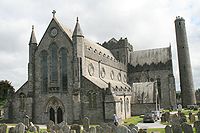
St Canice's Cathedral, also known as Kilkenny Cathedral, present building dates from the 13th century and is the second longest cathedral in Ireland. The Cathedral is named after St Canice, who also gave his name to the city.[10]
Cruciform, the cathedral was built in the Early English, or English Gothic, style of architecture, of limestone, with a low central tower supported on black marble columns. The exterior walls, apart from the gables, are embattled, and there are two small spires at the west end. The cathedral is seventy-five yards long, and its width along the transepts is forty-one yards.
Beside the cathedral stands a 100 foot, 9th century round tower. St Canice's tower an excellent example of a well-preserved early Christian (9th century) Round Tower. Accessible only by a steep set of internal ladders, it may once have been both a watchtower and a refuge, and the summit gives a good view of Kilkenny and the countryside around. The hill on which the cathedral stands is believed to be the centre of the first major settlement at Kilkenny, and the round tower suggests an early ecclesiastical foundation.[1]
Dominican Black Abbey was founded in 1225, and lying just off Parliament Street.
Old Woollen Mills
The Old Woollen Mills]] was built in the 1800s and is located on the north side of the city, on the Bleach Road. It was one of the largest employers in the area; the site covers 100,000 square feet and has more than a mile of river frontage onto the Nore. Among its many features is the original 75-foot chimney consisting of over 40,000 bricks.
Arts and Festivals
Kilkenny is encouraged as festival location throughout the year and especially during the summer months.
The Kilkenny Arts Festival established in the 1970s takes place in late August. During this time Kilkenny plays host to contemporary art with Theatre, Dance, Visual Art, Literature, Film, Paintings, Sculptures and live performances. Musical events including traditional, Classical, World, Jazz Music take place during the festival.
Kilkenny holds the annual Cat Laughs Comedy festival every June bank holiday week.
The Kilkenny Rhythm and Roots Festival is held on the first weekend in May every year and features the Americana/Bluegrass/Folk/Rockabilly/AltCountry artists in various venues throughout the city.
Venues such as the Watergate Theatre host a range of home-produced and touring performances in dance, music and theatre year-round.
Kilkenny cats
The expression "fighting like Kilkenny cats" comes from this town. The story is that Hessian soldiers in barracks in Kilkenny amused themselves by tying two cats together by the tails, then hanging them over a rope to fight. When an officer approached, who would have stopped the fun, a soldier drew his sword and quickly cut the cast down; when asked to explain the two bloody tails in the courtyard the soldier said that two cats had been fighting and devoured each other, leaving only the tails.
A later limerick-like poem puts it:
- There once were two cats of Kilkenny
- Each thought there was one cat too many
- So they fought and they hit
- And they scratched and they bit
- Till (excepting their nails
- And the tips of their tails)
- Instead of two cats there weren't any!
Sport
- Athletics: The Kilkenny City Harriers Club, formed in 1953
- Football: Kilkenny City AFC
- Rugby: Kilkenny RFC, founded in 1885
- Golf:
- Kilkenny Golf Club, an 18 hole championship parkland course close to city centre.
- Driving Range in Newpark
- Pocoke – an 18 hole all weather Par 3 golf course
- Mount Juliet Golf Course, a golf resort in Thomastown., considered one of the best in Ireland
- Ice Hockey: Kilkenny City Storm
- GAA (The Kilkenny branch of the Gaelic Athletic Association was founded in 1887).
- Hurling, the dominant GAA sport in the county:
- O'Loughlin Gaels GAA
- Dicksboro GAA
- James Stephens (GAA Club)
- Gaelic football
Outside links
| ("Wikimedia Commons" has material about Kilkenny) |
- Portal Site for Kilkenny
- Kilkenny Borough Council
- Live weather and climate details for kilkenny
- "Kilkenny" Encyclopædia Britannica. 2008. Encyclopædia Britannica Online.
- The Tidy Towns of Ireland "Celebrating 50 years"
- Online Kilkenny - resources for Kilkenny
References
- ↑ 1.0 1.1 Graves 1857, p. 25
- ↑ "Annals of the Four Masters, 1085 vol. ii
- ↑ 3.0 3.1 Graves 1857, p. 23
- ↑ Egan 1884
- ↑ Simms 1961
- ↑ "The History of the Kilkenny Borough Council". http://www.kilkennycity.ie/eng/Your_Council/The_History_of_Kilkenny_Borough_Council/.
- ↑ An exposed rock face can still be seen from the road.
- ↑ "Mediæval walls of Kilkenny City" (PDF). http://www.heritagecouncil.ie/fileadmin/user_upload/Publications/Irish_Walled_Towns/Med_KK_Walls.pdf.
- ↑ "City Walls Project". http://www.kilkennycity.ie/eng/Services/Heritage/City_Walls_Project/.
- ↑ CATHEDRAL of ST CANICE, extract from A Topographical Dictionary of Ireland (1837)
Books
- Anderson, Paris (1848). Nooks and Corners of County Kilkenny.. Kilkenny: Kilkenny People Printing Works, James's Street. http://www.askaboutireland.ie/aai-files/assets/ebooks/240_Nooks-and-Corners-of-County-Kilkenny/240_Nooks-and-Corners-of-County-Kilkenny.pdf.
- Bradley, John (2004). The treasures of Kilkenny.
- Bush, Andrew; Mark Haworth-Booth (1989). Bonnettstown: A House in Ireland. H.N. Abrams. ISBN 0-8109-0748-8..
- Carrigan, William (1905). History and Antiquities of the Diocese of Ossory, Volume 1.. Dublin: Sealy, Bryers and Walker. http://www.askaboutireland.ie/aai-files/assets/ebooks/183-185-186-190-History%20and%20Antiquities%20of%20the%20Diocese%20of%20Ossory/190-History%20and%20Antiquities%20of%20the%20Diocese%20of%20Ossory%20Vol%201.pdf.
- Carrigan, William (1905). History and Antiquities of the Diocese of Ossory, Volume 2.. Dublin: Sealy, Bryers and Walker. http://www.askaboutireland.ie/aai-files/assets/ebooks/183-185-186-190-History%20and%20Antiquities%20of%20the%20Diocese%20of%20Ossory/186-History%20and%20Antiquities%20of%20the%20Diocese%20of%20Ossory%20Vol%202.pdf.
- Carrigan, William (1905). History and Antiquities of the Diocese of Ossory, Volume 3.. Dublin: Sealy, Bryers and Walker. http://www.askaboutireland.ie/aai-files/assets/ebooks/183-185-186-190-History%20and%20Antiquities%20of%20the%20Diocese%20of%20Ossory/183-History%20and%20Antiquities%20of%20the%20Diocese%20of%20Ossory%20Vol%203.pdf.
- Carrigan, William (1905). History and Antiquities of the Diocese of Ossory, Volume 4.. Dublin: Sealy, Bryers and Walker. http://www.askaboutireland.ie/aai-files/assets/ebooks/183-185-186-190-History%20and%20Antiquities%20of%20the%20Diocese%20of%20Ossory/190-History%20and%20Antiquities%20of%20the%20Diocese%20of%20Ossory%20Vol%201.pdf.
- Chadwyck-Healey, Inc (1856). Notes and Queries. University of Michigan: Oxford University Press. http://books.google.com/?id=Wn0PAAAAIAAJ.
- Clarendon. De Ossoriensi Dioescesi. Clarendon Collection (tom. li. audit. number 4796); Trintity College, Dublin (E. 4.18).. pp. 19–30.
- Corcoran, Colm. The Life and Times of Kilkenny's Citizens..
- Cody, Brian (October 3, 2009). Cody. Kilkenny: Folens..
- Edwards, David (2000). The Ormond Lordship in County Kilkenny, 1515-1642: The Rise and Fall of Butler Feudal Power. Four Courts Press. ISBN 1-85182-578-9..
- Egan, P.M. (1884). "The illustrated guide to the city and county of Kilkenny". Kilkenny. http://www.askaboutireland.ie/aai-files/assets/ebooks/82-Egan-Kilkenny/82-Kilkenny.pdf.
- Fry, Plantagenet Somerset (1991). Routledge. ISBN 0-415-04888-5.
- Gale, Thompson (2004). "The Statutes of Kilkenny". Encyclopedia of Irish History and Culture. 1st ed..
- Gleeson, John; George Cunningham (1982). History of the Ely O'Carroll Territory Or Ancient Ormond. Roberts' Books. ISBN 0-907561-06-3. http://books.google.com/?id=NXbQHQAACAAJ..
- Graves, Rev. James (1857). The History, Architecture, and Antiquities of the Cathedral Church of St. Canice, Kilkenny. Grafton Street, Dublin.: Hodges, Smith, & co.. pp. 22. http://books.google.com/?id=Z_IDAAAAYAAJ.
- Healy, William (1893). "History and antiquities of Kilkenny (City and County). Volume 1". Kilkenny. http://www.askaboutireland.ie/aai-files/assets/ebooks/38-History-and-Antiquities-of-Kilkenny/38-History-and-Antiquities-of-Kilkenny.pdf.
- Hogan, John (1884). Kilkenny; the Ancient City of Ossory, the Seat of Its Kings, the See of Its Bishops and the Site of Its Cathedral. P. M. Egan. http://books.google.com/?id=vHmnGQAACAAJ..
- Heritage Council. Kilkenny City Walls Conservation Plan. Kilkenny: The Heritage Council. http://www.heritagecouncil.ie/publications/Kilkenny_Walls/..
- Jackson, Robert Wyse (1974). The Story of Kilkenny. Mercier Press. ISBN 0-85342-391-1..
- Kenny, Sean (2003). Every Stick and Stone that Stands Kilkenny. Kilkenny, Ireland: Sean Kenny. ISBN 0-9545741-0-9..
- Ledwich, Edward. Antiquities of Ireland. Banton Press (published 1991). ISBN 1-85652-025-0, 9781856520256. http://www.ucc.ie/celt/online/T100005B/text019.html.
- Lanigan, Katherine; Gerald Tyler (1987). Kilkenny: Its Architecture and History. Belfast: Appletree Press. ISBN 0-86281-180-5..
- Leonard, John (1996). A University for Kilkenny: Plans for a Royal College in the Seventeenth Century. St Canice's Press. ISBN 0-9528076-0-2..
- Mayor, F White (1999). The Castle on Kilkenny. Folens..
- Maloney, Danny (1986). An Individuals tale of Kilkenny. Kilkenny, Ireland: Palin & Son Publishing. p. 457..
- Masters (1085). "Annals of the Four Masters". http://www.ucc.ie/celt/published/T100005A/index.html.
- C. P. Meehan (1846). The Confederation of Kilkenny. Dublin: James Duffy. http://www.askaboutireland.ie/aai-files/assets/ebooks/221_Confederation-of-Kilkenny-Geraldines/221_Confederation-of-Kilkenny-Geraldines.pdf.
- Muldoon, James (2000). "Mediæval Notions of Difference". in Lang, Berel. Race and Racism in Theory and Practice. Rowman & Littlefield. ISBN 0-8476-9693-6.
- O'Brien, Karen (1367). "A Statute of the Fortieth Year of King Edward III., enacted in a parliament held in Kilkenny, A.D. 1367, before Lionel Duke of Clarence, Lord Lieutenant of Ireland". http://www.ucc.ie/celt/published/T300001-001/. Retrieved 2008-12-31.
- O'Carroll, Joseph C (1980). Historic Kilkenny: Kilkenny and It's Glorious Past, a Guide to Historic Kilkenny. Kilkenny People Ltd. http://books.google.com/?id=MpRzGwAACAAJ..
- Room, Adrian (2006). Placenames of the World (2 ed.). McFarland & Co Inc. ISBN 978-0-7864-2248-7. http://books.google.com/?id=M1JIPAN-eJ4C.
- Simms, Katherine (2005). "Gaelicization.". Mediæval Ireland An Encyclopedia. 1st ed.. Routledge.
- Simms, J.G (1961). Kilkenny in the Jacobite War, 1689-91. 13. Old Kilkenny Review..
- Sparks, May; Eric Bligh (1926). Kilkenny: Pen and picture pages of its story. Kilkenny: Kilkenny People office. http://www.askaboutireland.ie/aai-files/assets/ebooks/239_Kilkenny-Pen-and-Picture-Pages-of-its-History/239_Kilkenny-Pen-and-Picture-Pages-of-its-History.pdf..
- Tighe, W (1802). Statistical observations relative to the county of Kilkenny. Dublin: Graisberry and Campbell. http://www.askaboutireland.ie/aai-files/assets/ebooks/239_Kilkenny-Pen-and-Picture-Pages-of-its-History/239_Kilkenny-Pen-and-Picture-Pages-of-its-History.pdf.
| Cities in the Republic of Ireland |
|---|
